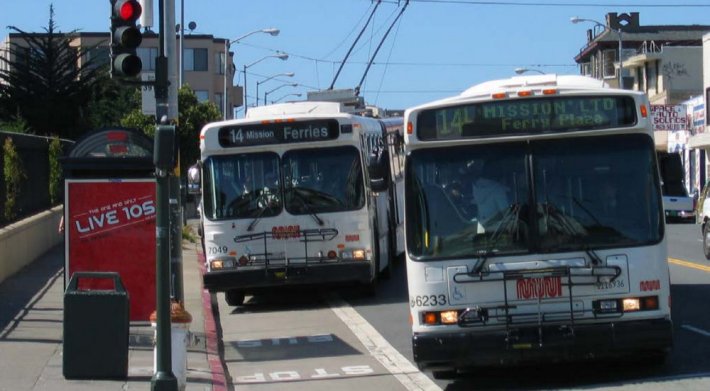The Muni Transit Effectiveness Project took a major step forward on March 28, when the SFMTA Board of Directors approved plans for route changes and street upgrades aimed at streamlining transit service. Judging from the headlines on major media reports, the vote sounded like a green light for the entire TEP. However, the reports glossed over some very important details.
While the "12 percent increase in service" trumpeted by the SFMTA's press release and heavily featured in newspapers might sound good, the TEP's plans have been watered down, and many of its juiciest transit-priority street alterations await far-off approvals. All told, successful implementation of the TEP is far from ensured.
After years of planning, public outreach, and revisions for 30-some Muni route re-alignments and frequency changes, six routes have been put on hold, and five dropped completely. The SFMTA Board has also only approved some of the Travel Time Reduction Proposals -- capital improvements to routes like transit bulb-outs, stop consolidations, and transit-only lanes. Those projects may bring some of the largest gains in transit speeds and ridership, but the SFMTA hasn't begun the public outreach process for most of them. Many route changes and TTRPs were watered down during public outreach, to appease people who complained about longer walks and removing car parking.
Meanwhile, an appeal against the Muni TEP's environmental impact report was filed just one hour after it was certified by the SF Planning Commission on March 27, although Muni TEP planning manager Sean Kennedy doesn't expect it to significantly delay implementation.
In announcing the SFMTA Board's recent vote, the agency sent out a press release with a headline touting a "12 percent increase in Muni service" resulting from the TEP. The increase apparently comes from a combination of speed improvements and increased funding, for which the agency is banking on three transportation funding measures planned for the ballot this November.
In recent years, the SFMTA had previously promoted a figure of 10 percent, not 12. When asked how that figure increased, Kennedy said the agency just extended the time frame which the figure applies to. "Instead of saying that we would do the whole increase in this [two-year] budget cycle, it basically just means we'll do all those increases and improvements, it might just be over the next two budget cycles," said Kennedy. "The time just draws out, not necessarily the projects."
The target also seems to assume the agency moves forward with all of the speed boosts expected from the TTRP street infrastructure changes -- most of which, again, haven't started public outreach yet. The TTRP improvements approved so far make up "maybe 10 percent," according to Kennedy's "off-the-cuff" estimate. "Definitely a small subset," he said.
So far, the precedent set by the initial TTRP upgrades isn't promising, as we saw with the plans for transit bulb-outs on Irving Street and Ninth Avenue in the Inner Sunset. That proposal, to widen sidewalks along the entire length of two-car N-Judah trains, was cut by more than half due to complaints about car parking and fire truck access.
In total, the TTRP projects encompass eleven Muni lines on six transit-heavy corridors. From the SFMTA website:
- J-Church: Balboa Park Station to Market
- L-Taraval: West Portal to SF Zoo
- N-Judah: La Playa to Cole
- 5-Fulton: La Playa to Market
- 8X-Bayshore Express: Geneva and Ocean to San Bruno and Silver
- 9-San Bruno: 11th and Market to Bayshore and Alemany
- 14/14L-Mission/Mission Limited: Daly City BART to Embarcadero
- 22-Fillmore: Church and 16th to 3rd and 16th
- 28/28L-19th Avenue/19th Avenue Limited: Junipero Serra to California
- 30-Stockton: Van Ness and Chestnut to Stockton and Market
- 71-Haight Noriega: Laguna to Stanyan
The subset approved by the SFMTA Board on March 28 includes sections that the agency chose to "fast track" to coordinate with already planned street re-pavings and re-designs. These include the 71 in the Lower Haight, the N-Judah on Irving and Judah, the 30-Stockton on Columbus, bus bulbs for the 14 at Mission Street and Silver Avenue, the re-design of Potrero Avenue in the Mission, and the 5-Fulton west of 25th Avenue (where the SFMTA launched the 5L-Fulton Limited and other changes in a pilot project last year).
The route re-alignments and frequency changes that were put on hold were the 19-Polk, 48-Quintara 24th Street (east of Potrero Avenue), 58-24th Street, 23-Monterey, 54-Felton, and 90/91A/91B Owl routes. Kennedy said the SFMTA would hold more outreach meetings for these lines in the coming months.
Route changes that were abandoned were the 27-Bryant, 32-Roosevelt, 36-Teresita, 37-Corbett, and 56-Rutland. As we reported, riders on Bryant Street in the Mission fought plans to re-route the 27-Bryant onto Folsom Street.
The SFMTA hasn't changed its planned schedule, whereby the entire TEP will be implemented by 2017. As we reported in January, however, the agency is already behind on its plans to install transit priority on half the city's traffic signals by this spring, with only 170 of 600 completed by that time.
Kennedy said outreach for the rest of the TTRP projects is expected to begin this fall at the earliest.





